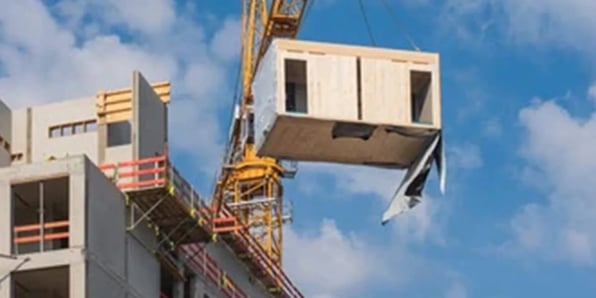
India is building a new modular construction paradigm
Mark Twain had nothing bad to say about the service at Watson’s Esplanade Hotel in what was then Bombay: his gripe was about quantity, the sheer volume of white suited, starched and over eager attendants tracking his every move and dishing up tea and tiffin every five minutes. History doesn't tell us whether Joseph Conrad or Rudyard Kipling had the same reservations, but both of made a beeline for Watson’s Esplanade when they were staying in India: it was, after all, one of the subcontinent's and Asia’s most luxurious hotels.
Not anymore…
The cavernous hulk of the Esplanade Mansion (now re-branded for our more prosaic times) is a decrepit shell of a building, echoing to its rafters and rusting to its Victorian core. Local Courts are currently deciding whether it should be demolished altogether, despite its cultural and historic significance and despite it now being home to dozens of Mumbai’s poorest families.
And the Esplanade Mansion is by no means alone: in May this year Mumbai’s Central Municipal Council identified no less than 499 buildings in the City in a dangerously run-down condition (down from 619 last year but that’s hardly a cause to celebrate), and in August this year the Court ordered 23 seriously dilapidated apartment blocks to be demolished: in the same month the sprawling Navrang Building caught fire and collapsed before it could be pulled down (killing one labourer) and in June the Kesarbai multi-storey apartment block, designated for demolition as long ago as 2017, collapsed leaving 24 families homeless (although, mercifully, unhurt).
According to Google, there are currently more than 3,500-registered demolition companies in Mumbai, so it’s not as though there aren’t enough of them to make sure Court Orders are listened to. So what’s going on?
Well, for a start, it costs an average of $18,000 to demolish even a small family home, never mind a multi-storey block like the Navrang Building and these “end of use” costs are quite literally stored up by traditional construction projects dating back to Victorian times, sunk immovably into the fabric of the building for future generations to pick up. And in the case of the impoverished neighbourhoods of Mumbai, that’s usually one cost too far, so many have little choice but to continue living in dangerous and unhealthy buildings like the Navrang and the Kesarbai, and all too often they’re dying in them too.
That’s a particularly graphic and harrowing illustration of the housing bottleneck facing Prime Minister Modi’s Government as it continues to push through the Affordable Housing Program, delivering the dwellings India’s urban poor so desperately need so that Navrang and Kesarbai can become a thing of the past. The Government is now on track to build 10,000,000 new homes by 2022 (in line with policy targets), making use of key initiatives such as RERA, GST and new tax breaks to steadily help address this pressing issue. But if the scale of the Government’s ambition is large, the challenge is larger still: millions of people are continuing to move from rural India in to the subcontinent’s urban conurbations so something more is required.
And in such challenging circumstances, Modular Construction may well be the answer: delivering new housing at the accelerated rate India needs, with design to handover periods half those of traditional technologies, construction costs lower and simultaneous completion systems allowing for tighter completion scheduling in absolute terms. For those in the most pressing need and those striving to look after them, those are hard facts that can’t be ignored. And, unlike conventional technologies, modular construction doesn’t store up excessive costs for the future either: once the building has come to the end of its useful life it can be readily disassembled or even removed altogether for reassembly elsewhere.
All of which might be bad news for Mumbai’s 3,500 demolition firms, but it is very good news for the rest of us.

Modulex Construction is the World’s largest and India’s first Steel Modular Building Company, working to meet the opportunities of India’s real estate markets in a practical and focussed manner. It was established by Red Ribbon to harness the full potential of these fast-evolving markets and deliver exciting opportunities for investors: because, when it comes to investing on the subcontinent, nobody knows its markets better than Red Ribbon.
Executive Overview
With an increasingly urbanised and rapidly burgeoning population, it is simply impossible to understate the scale of the current housing challenge facing India: and although Prime Minister Modi’s Government has made huge strides to bring the Affordable Housing Program to a successful conclusion by its target date of 2022, it should be obvious to all of us that the remaining challenges are still immense.
That’s why I’m convinced Modular construction will be a major contributor to providing a workable solution that is also capable of delivering to the pace India needs.
Modular Construction schedules are half those of traditional building technologies. It’s also cheaper, more resilient, less labour intensive and better for the environment.
To get things right, and like most things, a workable solution will call for a variety of approaches, but I’m sure Modular Construction will be one of them.

%20(1).jpg?width=596&name=airport-terminal%20(1)%20(1).jpg)

-Oct-11-2023-11-53-18-4937-AM.png?width=596&name=Untitled%20design%20(3)-Oct-11-2023-11-53-18-4937-AM.png)